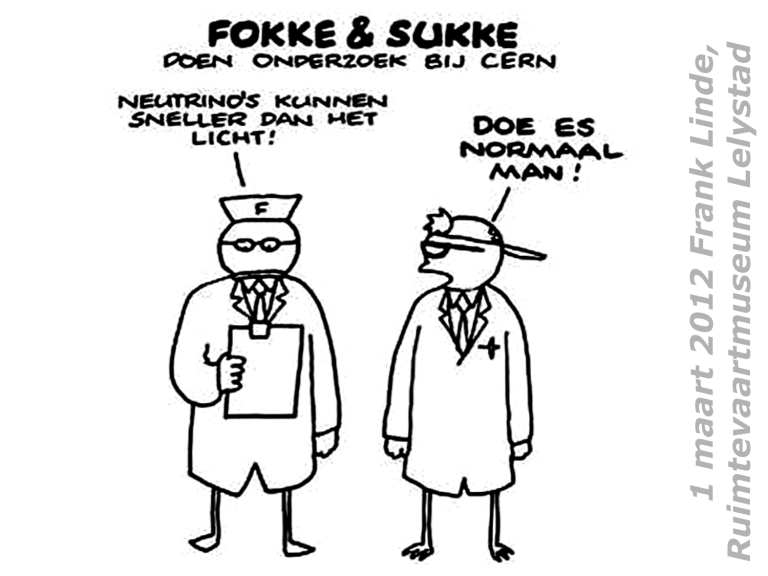
1 maart 2012 Frank Linde,
Ruimtevaartmuseum Lelystad
Lang geleden …
Empedocles
Plato
Aristoteles
Leucippus
Democritus
Het Periodiekperiodiek
Systeem systeem
Mendeleev’s
nummering: kernlading
Nobel gasses
Not part of the
original Mendeleev
periodic table
Quark model: Gell-mann (1964)
Het elektron
Massa:
0.000000000000000000000000000910938188 gram
Elektrische lading:
0.00000000000000000016021765 Coulomb
Gemiddelde levensduur:
(oneindig) seconden
”Spin”: ½
Het neutrino
Massa:
<0.0000000000000000000000000000000039 gram
Elektrische lading:
0 Coulomb
Gemiddelde levensduur:
(oneindig) seconden
”Spin”: ½
2-deeltjes “verval”
+e+e
e+
+
++
+
e
-massa 0
2000
A neutrino experiment at Fermilab has seen
the first direct evidence for the tau neutrino,
the most elusive of the 12 particles that make
up the Standard Model of the fundamental
structure of matter.
e
antimaterie
materie
Leptonen=lichte deeltjes
e
e
I
II
III
+
e
+
+
e
+
+
X X’
41H4He+2e++2e
2e+energie
zijn
’s
zeldzaam?
supernova SN1987A neutrino’s
supernova SN1987A neutrino’s
CNGS
CERN Neutrino’s to Gran Sasso
afstand
snelheid =
tijd
CERN
p
CERN
productie
,K, …
verval
K
bundel
Tijdprofiel “-pulse” at CERN
protons
, K, …
~10,000 ns
protons
, K, …
~10,000 ns
LNGS:
Laboratori Nazionali del Gran Sasso
OPERA detector
-bundel
Eén OPERA event
protons
on target
100,000,000,000,000,000,000 “POT”
~100,000,000,000,000,000,000 Gran Sasso
~16,000 -interacties
Eén OPERA event
De meting
Afstand CERN-OPERA: 731278.00.2 meter
Tijdverschil CERN-OPERA: 0.00000001 s = 10 ns
stat: 6.9 ns & sys: 7.4 ns
Het resultaat
vergelijk
gemeten
&
voorspelde
tijdspectra
shift
correcties
6010 ns
sneller dan
het licht!
ICARUS
BOREXINO
Vervolgmetingen
Hoe verder?
en ▪▪▪ ▪ ▪ ▪ check de calibraties
Japan
U.S.A.
“NuMi”
720 km
“T2K”
295 km
Intermezzo: Einstein & relativiteit
Reizen in de toekomst kan “gewoon”!
‘tik’ van de lichtklok in rust: t
L
‘heen-en-weer’
periode t van het licht:
2L
t=
c
c=299792458 m/s (exact)
waarnemer in rust
c=299792458 m/s (exact)
‘tik’ van de lichtklok in beweging: t’
‘heen-en-weer’
periode t’ van het licht:
v [m/s]
L
2L2+(½vt’)2
t’ =
c
(ct’)2 = 4L2+(vt’)2
t
t’ = 2L =
t
c2v2 1v2/c2
½vt’
vt’
bewegend klokje tikt langzamer!
waarnemer beweegt met snelheid v
Breaking news (last week!)
The OPERA collaboration has informed its funding agencies
and host laboratories that it has identified two possible
effects that could have an influence on its neutrino timing
measurement. These both require further tests with a
short pulsed beam. If confirmed, one would increase the
size of the measured effect, the other would diminish it.
The first possible effect concerns an oscillator used to
provide the time stamps for GPS synchronizations. It could
have led to an overestimate of the neutrino's time of flight.
The second concerns the optical fibre connector that brings
the external GPS signal to the OPERA master clock, which
may not have been functioning correctly when the
measurements were taken. If this is the case, it could have
led to an underestimate of the time of flight of the
neutrinos. The potential extent of these two effects is
being studied by the OPERA collaboration. New
measurements with short pulsed beams are scheduled for
May.
Implicatie: oorzaak gevolg
